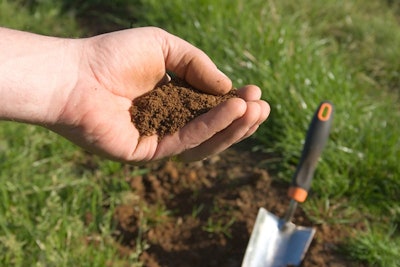1. Conduct a soil test.
WHY: Clay soils pose a challenge to the root systems of many plants. Heavy clay soils tend to drain poorly and are more likely to be compacted, limiting aeration and pore space for roots to breathe and grow.
Despite these inadequacies, clay soils have redeeming qualities, retaining moisture and nutrients better than sand and silt, making them a potentially rich growing medium when improved with amendments.
Though the task of working with it can be challenging, the process of amending clay soil to workable condition is practical and well worth the effort.
Soil conditioner breaks down into organic matter and aids drainage.
Take soil samples from several locations within the planting site and send them to your agricultural extension soil lab for testing. Some labs offer recommendations on amendments for your soil type.
2. Develop a plan of action.
Review the proposed site plans, including planting plan and bed layout. Before buying, consult with your soil materials provider to determine needed soil amendments.
TIP
Avoid using sand or peat moss, whose properties interact with clay particles to retain moisture and create an undesirable soil texture.
Expanded shale slowly releases water and has large particle size that aids drainage.3. Calculate and purchase soil amendments.
Multiply the planting bed’s length by width to determine square footage. Calculate the volume of needed amendments by multiplying the bed’s square footage by the recommended three inches (1/4 foot) for each layer of amendment.
Soil amendments are sold by the cubic yard, so to convert the volume from cubic feet to cubic yards, divide the cubic footage by 27. (27 cubic feet equals 1 cubic yard)
4. Organize equipment, such as colored flags, rakes, shovels, rototiller and front-end loader.
5. Prepare the site.
If needed, have underground utilities marked. Mark the outline of planting bed and remove obstructions.
6. Work in soil amendments.
Loosen existing soil and break up clods. Apply a 3-inch layer of the soil amendment and work to a depth of 6 inches with rototiller. Add amendments one at a time.
~~By Susan Morgan









